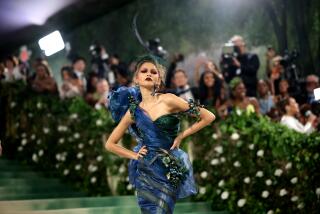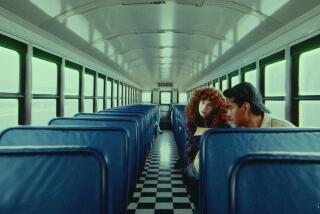Second nature
The Huntington’s “An Eye for Beauty: Collectors and the History of British Watercolor” is hardly the hippest exhibition in town this season -- I for one have long considered John Constable, one of its stars, among the most boring artists in all of art history -- but it’s a must-see for any true lover of painting.
The works, which date from the early 18th century through mid-19th century, aren’t especially innovative by contemporary standards. The subjects are conventional, the themes traditional, the renderings naturalistic. The works’ mid-20th century collectors, around whose perspective the exhibition is organized, are also a staid bunch, their concerns far removed from those of the typical 21st century viewer. Yet it’s difficult to deny, as these collectors maintained, that watercolor achieved in this era something close to perfection.
Whether in the skies of J.M.W. Turner, the architecture of John Ruskin, the greenery, even, of Constable, or else the trees, ships, cathedrals, mountain peaks, country paths, rural villages, livestock, ports or palaces of the several dozen lesser-known artists also included in the show, one easily forgets the historical distance, so thrilling is the experience, in the best works, of such exquisitely manipulated paint.
At the root of the work’s potency is an auspicious synthesis of medium and sensibility. This was the dawn of the Industrial Revolution, when the rise of the machine was blackening the landscape across Britain and spurring the widespread romanticization of nature and human experience. It was the age of Blake, Wordsworth and Coleridge, of works like “Ah Sun-flower,” “The Garden of Love,” and “She Dwelt Among the Untrodden Ways.”
Watercolor is a medium uniquely suited to the representation of nature, and particularly to conveying a sense of intimacy with nature. It’s relatively portable; many of the works assembled appear to have been sketched, if not completed, on site. It’s thin and dries quickly, which implies a direct involvement and immediacy. Most importantly, perhaps, it’s atmospheric. It suggests water and air -- hence the preponderance of sea- and skyscapes. Skillfully handled, it mimics the transparency of light.
All but a handful of the paintings in the exhibition are landscapes. Adhering to the terms favored by 20th century connoisseurs and collectors, the show divides these roughly into two categories: the pictorial and the topographical. The former take a poetic approach to nature, portraying scenes that are often entirely imaginative and intended to convey an emotional experience. Among the loveliest is “Blasted Tree in a Landscape” by Alexander Cozens, who was known to invent scenes by building upon several quick, random brush strokes made on a piece of slightly crumpled paper.
The topographical works document actual places and spoke to the growing appetite among the British for domestic and foreign travel. Here we find the seeds of the modern postcard industry: representations, often strenuously precise, of churches, castles, palaces, famous vistas, ruins and monuments.
Needless to say, the categories blur considerably: The pictorial works are decidedly naturalistic (William Blake’s peculiar “Moses Placed in the Ark of the Bulrushes” being the only obvious exception), and the topographical works are loaded with pictorial flourishes.
Stylistically, the paintings range from tight and almost photorealistic, such as William Capon’s “Old Gateway, Charterhouse,” to the impressionistically loose “View of Bregenz,” an exquisite late sketch by Turner.
The former served a purpose that is no doubt largely lost on a post-photographic audience, and these pieces tend to be the least compelling. The latter end of the spectrum includes some of the most exciting works in the show, including the Turner; a charming Thomas Gainsborough sketch of a herdsman with his flock at a pond; a beautiful portrayal by George Chinnery of a shrine in India; and David Cox’s luscious beach scene, “The Sea Front at Blackpool.”
Between these two extremes lie a number of works characterized by heavy outlines and buoyant, full-bodied forms. Although the Turners, the Gainsboroughs and the Coxes speak to a Romantic sensibility -- one that has filtered into our era but largely in the form of sentimental calendars and greeting cards -- many of these look surprisingly contemporary and point to another, less expected affinity: between these artists and the cartoonists, comic book artists and illustrators of today. Whether one could argue for a direct lineage -- it’s an interesting possibility -- anyone with a fondness for the latter genres will surely find much to appreciate.
The most overtly cartoonish are the caricatures of Thomas Rowlandson, which constitute most of the show’s nonlandscape works. Among the best of these are “The Life Class,” a very funny drawing portraying a fresh-faced, nude young woman posing for a crowd of vulturous old men, and “Guards Marching Through Holland,” a military scene overshadowed by gathering of fantastically rendered trees.
Among the outstanding landscapes in this vein are John Sell Cotman’s drawing of the rocky peaks surrounding the medieval town of Domfront in Normandy; Edward Lear’s study of an ancient quarry in Greece; and Joseph Farington’s beautiful sketch, gently washed in pale blue and tan, of Dumbarton Rock in Scotland.
In addition to the 18th and 19th century works (most drawn from the William Spooner Collection at the Courtauld Institute of Art Gallery in London or the Gilbert Davis Collection at the Huntington), the exhibition includes a sampling of mostly forgettable early 20th century works. The idea, according to the wall text, is to illustrate “how museums and collectors today have expanded their focus, giving later artists their due place within the history of watercolor painting in Britain,” but the effect is really only to affirm the early collectors’ tendency to stop at 1900.
It isn’t, of course, that great watercolors haven’t been made since then, but not on this scale -- not in so cohesive and perfect a flourish. There are surely more ways to employ the medium than the naturalistic portrayal of trees, crumbling architecture, and pastoral vistas, but as far as those things are concerned, it doesn’t get much better than this.
*
‘An Eye for Beauty’
Collectors and the History of British Watercolors
Where: The Huntington Library, Art Collections, and Botanical Gardens, 1151 Oxford Road, San Marino
When: Noon to 4:30 p.m. Tuesdays through Fridays, 10:30 a.m. to 4:30 p.m. Saturdays and Sundays, closed Mondays
Ends: May 15
Price: $15 adults, $12 seniors, $10 students, $6 youth 5 to 11, free for children younger than 5
Contact: (626) 405-2100, www.huntington.org
More to Read
The biggest entertainment stories
Get our big stories about Hollywood, film, television, music, arts, culture and more right in your inbox as soon as they publish.
You may occasionally receive promotional content from the Los Angeles Times.






